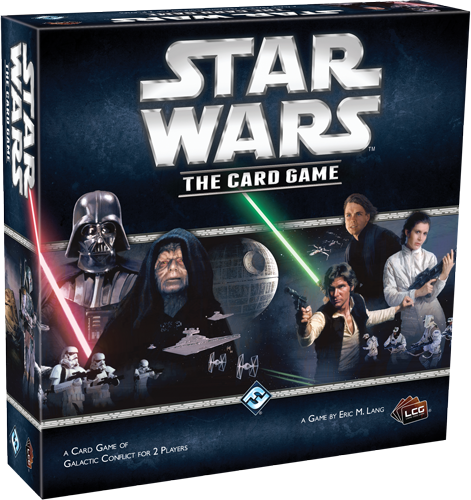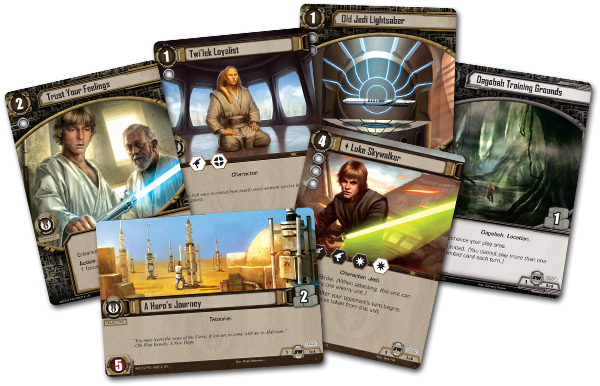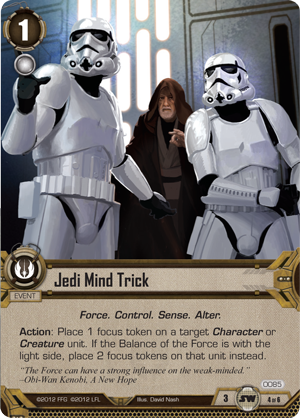 Fantasy Flight Games continues to flex the muscle of the Star War license as they prepare to bring us Star Wars: The Card Game. This looks like a title to watch as if the company?s Lord of the Rings: The Card Game is any indication (and Elliott and I both like that game quite a lot!) we could be looking at a new deck building behemoth! Two players will go head to head while controlling such famous Star Wars characters such as?Luke Skywalker, Han Solo, Leia Organa, Boba Fett, and Darth Vader. A successful game design might as well mean FFG can practically print money as this will be a huge seller even outside of the usual gaming avenues. No specific release date yet but by all accounts we should see the title before the end of the year. Star Wars: The Card Game carries an MSRP of $39.95.
Fantasy Flight Games continues to flex the muscle of the Star War license as they prepare to bring us Star Wars: The Card Game. This looks like a title to watch as if the company?s Lord of the Rings: The Card Game is any indication (and Elliott and I both like that game quite a lot!) we could be looking at a new deck building behemoth! Two players will go head to head while controlling such famous Star Wars characters such as?Luke Skywalker, Han Solo, Leia Organa, Boba Fett, and Darth Vader. A successful game design might as well mean FFG can practically print money as this will be a huge seller even outside of the usual gaming avenues. No specific release date yet but by all accounts we should see the title before the end of the year. Star Wars: The Card Game carries an MSRP of $39.95.
From FFG:
?This station is now the ultimate power in the universe.?
?Admiral Motti, Star Wars: A New Hope
The Imperial fleet sifts through the galaxy for signs of the Rebel Alliance?s hidden base, hoping to obliterate it with one powerful blast from their newly constructed Death Star. As the Empire?s imposing Star Destroyers draw near, the Rebels realize there is no time to spare, so they mobilize for a desperate attack. Squadrons of starfighters launch into space. Their pilots know that many of them may soon make the ultimate sacrifice for galactic freedom?
The characters, starships, and situations of the original Star Wars trilogy come to life in Star Wars: The Card Game?. A game by award-winning designer Eric M. Lang, Star Wars: The Card Game is a head-to-head Living Card Game? of tactical combat, and strategic planning that allows two players to wage cinematic battles between the light and dark sides of the Force.
Decide the Fate of the Galaxy
?I?m taking Captain Solo and his friends. You can either profit by this? or be destroyed! It?s your choice.?
?Luke Skywalker, Star Wars: Return of the Jedi
In Star Wars: The Card Game, light side and dark side players duel for the fate of the galaxy. While the light side player races to make tactical strikes against dark side objectives, the dark side player works to reinforce his position of command.
Throughout the game, the dark side works to snuff out the last remnants of its opposition and secure total control of the galaxy. This is represented by advancing the game?s Death Star dial.  The dark side advances the dial at the beginning of each of its turns and can accelerate its advancement by launching successful attacks against the light side. If the dial advances to ?12,? the dark side wins. Given enough time, the dark side player will discover the last remnants of the light side?s resistance, and wipe them out of the galaxy with one final, commanding gesture.
The dark side advances the dial at the beginning of each of its turns and can accelerate its advancement by launching successful attacks against the light side. If the dial advances to ?12,? the dark side wins. Given enough time, the dark side player will discover the last remnants of the light side?s resistance, and wipe them out of the galaxy with one final, commanding gesture.
Thus, just like in the movies, time is always running out for the light side, and its heroes must find the means to strike quickly and for maximum damage. The light side player wins by destroying three dark side objectives, cards that represent a player?s missions or strategies. However, destroying an opponent?s objective requires getting sufficient firepower past Imperial defenses.
Most of this firepower will come from unit cards, representing the characters, creatures, droids, vehicles, and starships that players may use to strike against their opponents. Enhancements like skills, weapons, and other items make your units more effective in battle, while other enhancements like locations can allow you to expand your play area and accelerate your strategy. The faster you can accelerate your strategy, the faster you can launch massive starships like Home One or Devastator.
Meanwhile, it pays to carry some tricks up your sleeve (or hidden in your armor), and events represent the unexpected developments of the battlefield ? daring maneuvers, special powers, disasters, traps, and other sudden effects.
Elegant Mechanics
?This is the weapon of a Jedi Knight. Not as clumsy or as random as a blaster.?
?Obi-Wan Kenobi, Star Wars: A New Hope
Star Wars: The Card Game offers a straightforward and accessible play experience. Each turn, players mobilize their forces, drawing upon their resources to deploy characters and starships and launch them into battle. Several new mechanics propel the game forward, adding to the drama while keeping players focused on the action.
To play cards, players must spend the resources they generate by placing ?focus? tokens on their ready affiliation cards and objectives. Some units and enhancements also contain icons with resource values, and players can use these cards to generate resources, as well.
Placing a focus token on a card indicates that it has been committed to a specific activity or course of action. Until a card has a focus token on it, it is considered ?ready,? but once given a focus token, the card is then exhausted. Exhausted cards can?t be used again to generate resources or take actions until after their controllers have removed all focus tokens from them. Typically, players remove one token from each of their cards during the refresh phase, but some cards can be ?focused? twice in a single moment, and some cards allow players to place focus tokens upon their opponent?s units, luring them deeper down the paths they have chosen. This can leave them unable to fully refresh on their next turn and, thus, unable to respond to alternate threats.

The dark side player places a focus token on Grand Moff Tarkin to generate a resource.
While the focus mechanic permits greater tactical depth than the simple binary dynamic of ?used or available? found in most card games, it also adds an exciting dimension to the game?s combats where units must focus to strike against their opponents.
?Beware of the dark side. Anger?fear?aggression. The dark side of the Force are they. Easily they flow, quick to join you in a fight. If once you start down the dark path, forever will it dominate your destiny.?
?Yoda, Star Wars: The Empire Strikes Back
The original Star Wars trilogy is loaded with thrilling and direct confrontations between opposing starfighters and squads of Rebel and Imperial troopers. Smugglers confront bounty hunters, and Jedi face off against Sith in epic lightsaber duels. The trilogy is also full of daring tactical maneuvers and cunning ploys to buy the heroes just enough time for their plans to come together. Likewise, during combats, the focus mechanic permits players to feint or otherwise manipulate their opponents.
Combat in Star Wars: The Card Game is deadly and dramatic. It begins when a player forms a team of units to assault an opponent?s objective. Once the opponent declares which units will defend, both players maneuver for the stronger opening position in a tense ?edge battle.?
In an edge battle, players vie for initiative by secretly bidding cards from their hand facedown, one at a time, beginning with the active player. Once both players have passed or run out of cards to bid, they compare the number of Force icons on the cards they?ve bid, the cards they bid are discarded, and the winner gains the edge, earning the right to strike first.
To strike, an attacking or defending unit focuses. Then it applies the effects of all its combat icons.
![]() ?Unit damage: Deal one point of damage per unit damage icon to an opposing unit in the same combat. If a unit takes an amount of damage equal to its hit points, it is destroyed.
?Unit damage: Deal one point of damage per unit damage icon to an opposing unit in the same combat. If a unit takes an amount of damage equal to its hit points, it is destroyed.
![]() ?Blast damage: When it strikes, an attacking unit may deal one point of damage per blast damage icon to the attacked objective.
?Blast damage: When it strikes, an attacking unit may deal one point of damage per blast damage icon to the attacked objective.
![]() ?Tactics: Place one focus token on an enemy unit. This cunning ploy may prevent an enemy unit from striking in combat, or it can disrupt your opponent?s plans by exhausting a unit your opponent had intended to utilize later in the turn.
?Tactics: Place one focus token on an enemy unit. This cunning ploy may prevent an enemy unit from striking in combat, or it can disrupt your opponent?s plans by exhausting a unit your opponent had intended to utilize later in the turn.
It pays to win the higher ground, and the player who gains the edge may earn benefits beyond the right to strike first. The player with the edge may also gain the upper hand with additional, situational combat icons.
The edge battles of Star Wars: The Card Game ensure that no cards in a player?s hand are ever without value. The dramatic tactical advantages won by the player with the edge may sometimes grant more worth to a card in a player?s hand than it would have on the table. As light and dark side players look for every weakness they can find in their enemies? defenses, they?ll develop clever strategies to draw cards out of each other?s hands prior to key edge battles. Just like in the movies, you may find your foe full of surprises, and to win the edge you?ll need to master the vital skills of hand management.
Finally, at the end of each turn players enter the Force phase, where they seek to sway the balance of the Force by committing their units to the light side or the dark side. Committed units add their Force icons to the Force struggle, and the player with more committed Force icons flips the game?s Force card in his side?s favor. However, such commitment to the Force comes with a burden, and when a unit committed to the Force strikes in combat during subsequent rounds, it receives two focus tokens instead of one.

Still, the Force flows through all things and binds them together, and the balance of the Force has a profound effect upon the game. When the balance of the Force tilts in favor of the light side, the light side player may deal one damage to a dark side objective each turn. When the balance of the Force favors the dark side, the dark side player advances the Death Star dial an extra point each turn.
The Future You See
?Everything is proceeding as I have foreseen.?
?Emperor Palpatine, Star Wars: Return of the Jedi
Star Wars: The Card Game takes the LCG model in an exciting new direction, pursuing an innovative new style of set-focused deck-building!
Each player chooses an affiliation card and a stack of ten or more objective sets. Each objective set includes six cards: one objective and five corresponding cards that go into a player?s command deck. The compositions of players? command decks are automatically determined by the objective sets they choose. This brand new model makes deck-building more accessible to new players, as they have only to select ten objective sets and combine them rather than assemble an entire deck, individual card by individual card.

This model also presents a compelling new deck-building challenge for veteran card players. Traditionally, veteran players approach customizable card games by evaluating the worth of every individual card in a deck. Star Wars: The Card Game, however, explores exciting new design territory; players are faced with the task of evaluating groups of cards and building a deck by selecting among those groups. This new approach allows for intense strategic customization, while still maintaining core thematic elements from the Star Wars saga.
Faster deck-building and truly awesome legends ? that?s the idea behind the new deck-building model of Star Wars: The Card Game!
Daring Heroes and Memorable Villains
?Look, I ain?t in this for your revolution, and I?m not in it for you, Princess. I expect to be well paid. I?m in it for the money!?
?Han Solo, Star Wars: A New Hope
The Star Wars: The Card Game Core Set presents four fully developed starter decks that can be played out of the box, two each for the light and dark side. Each starter deck allows players to command one of four different affiliations:
 Imperial Navy: The Empire established command of the galaxy through the strength of its massive fleet. The Imperial Navy faction excels at spreading out across the galaxy with capital ships, starfighters, troopers, and visionary leaders such as Grand Moff Tarkin.
Imperial Navy: The Empire established command of the galaxy through the strength of its massive fleet. The Imperial Navy faction excels at spreading out across the galaxy with capital ships, starfighters, troopers, and visionary leaders such as Grand Moff Tarkin.- Sith: Drawing upon the tremendous power of the dark side of the Force, the Sith rule the galaxy through fear. Led by Emperor Palpatine and the dark lord, Darth Vader, the Sith aim to crush their opponents? throats and ambitions.
- Rebel Alliance: Borne upon the wings of starfighters and the backs of Rebel troopers, the spark of freedom still flickers throughout the galaxy. Leia Organa, Admiral Ackbar, and other leaders of the Rebel Alliance call upon their pilots and soldiers to make quick, tactical strikes against the Empire.
- Jedi: The fire of these adherents to the Old Ways has not completely extinguished. Luke Skywalker, Obi-Wan, Yoda, and others ally themselves with the light side of the Force. They make good use of their training, their Jedi mind tricks, and their finely-crafted lightsabers.
Much as the different affiliations work toward a common cause in the original films, they can join together in Star Wars: The Card Game to rule or save the galaxy. Players who take advantage of the game?s deck-building options can mix affiliations from the same side of the Force.
Additionally, the Core Set will grant players their first taste of two other affiliations to be further developed in expansions to come.
- Smugglers and Spies: This affiliation features the light side?s heroic rogues and scoundrels, typified by Han Solo. They?re tricksters and fighters who make good use of their quick minds and quick reflexes.
- Scum and Villains: Money can?t solve every problem, but it can buy a lot of answers. With a cast of unscrupulous characters like Boba Fett, a host of enhancements, and tricky tactics, this affiliation more than proves it?s worth every credit.
The characters and themes of Star Wars come to life during the thrilling battles of Star Wars: The Card Game!
?
Jeff McAleer
Founder, Editor-in-Chief, and Host of the TGG podcasts. Jeff tackles any and all topics but his main focus is war and strategy, RPGs, and miniatures. He also never lacks for an opinion...
More articles by Jeff McAleer ?Source: http://thegaminggang.com/2012/11/star-wars-the-card-game-to-arrive-soon/
smokey robinson pulmonary embolism packages camila alves albrecht durer dan marino david lee roth
No comments:
Post a Comment
Note: Only a member of this blog may post a comment.